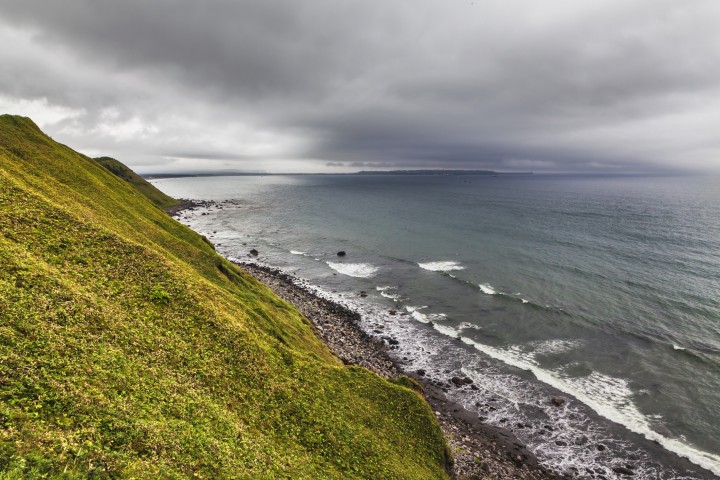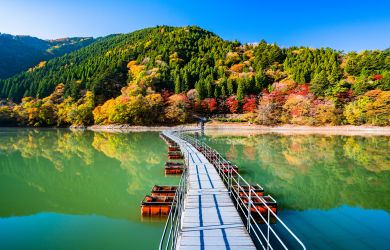
January 7, 2017
Dark Clouds Over Idyllic Islands
Finding an end to Japan and Russia's decades-long territorial dispute.
By Steve Morton
Stretching out over the Sea of Okhotsk from Hokkaido’s northern coast lies a group of sparsely populated islands connecting Japan geographically with its closest neighbor, Russia. In this innocent corner of the earth simmers a conflict which has continued to divide the two nations politically since the end of the Second World War.
Now entering its 71st year, this conflict centers on a tiny chain of islands known as the “Northern Territories” in Japan and the “South Kuril Islands” in Russia. Consisting of the three main islands of Etorofu, Kunashiri and Shiokan, and a group of rocks known as Habomai-shoto, Japan administered this territory from 1855 until 1945, when it was seized by Soviet forces. Since then this territory has remained under Russian control. Because of this dispute, both sides have remained technically locked in a state of war since 1945 as no peace treaty has ever been agreed upon.
In order for any treaty to be finalized, Japan demands that Russia return all of these islands, while Russia maintains that Japan must recognize Russian sovereignty. In exchange for this, Russia would then be willing to negotiate transferring some of these islands back to Japan upon the successful conclusion of a peace treaty.
While many outsiders might consider this a classic case of a Russian land grab, the historical realities are more complex.
During the Yalta conference near the end of World War II, the Allies hoped to hasten the end of the war and reduce casualties by requesting Soviet help in the fight against Japan. In exchange for entering the war against Japan—which effectively meant Moscow breaking the Soviet-Japanese Neutrality Pact—the allies promised Stalin that, among other things, “the Kuril Islands shall be handed over to the Soviet Union.” After Japan’s unconditional surrender on August 15, the allies agreed to set a future date to finalize these key points.
This would occur during negotiations of the San Francisco Treaty in 1951 when Japan formally conceded sovereignty of these islands. A key part of this agreement stated that Japan would “renounce all rights, title and claim to the Kuril Island chain.” However, after Japan officially relinquished its rights, events took a dramatic turn when Japan’s Foreign Ministry suddenly claimed that the Northern Territories were not included in this treaty since it never recognized the islands of Etorofu and Kunashiri as being part of the Kurils.
This argument is easily refuted by numerous official Japanese documents and maps at the time, which clearly show both of these islands as part of the Kurils. Furthermore, Japan’s own director of treaties, Kumao Nishimura, stated on October 19, 1951, that Etorofu and Kunashiri were part of the Kurils.
This controversial claim was, however, endorsed by the United States along with 48 other nations. Meanwhile, the Soviet Union refused to sign a treaty that broke one of its key pre-conditions for entering the war with Japan in the first place.
The West’s endorsement of Japan’s untenable position can best be understood in the context of the Cold War ideology, as the Soviet Union had now become a perceived threat to world democracy.
Part of this Cold War posturing occurred again in 1956 during the Soviet-Japan declaration, when Japan agreed to concede sovereignty over Etorofu and Kunashiri Islands in exchange for securing the return of Shikotan and Habomai Islands. However, this historical agreement was blocked by the United States, which threatened to keep Okinawa if Japan made any concessions to the Soviet Union.
Though it has been decades since the end of the Cold War and the collapse of the Soviet Union, the deadlock remains. For its part, Russia has consistently maintained the same position as originally set out in the Soviet-Japan treaty, while Japan has fluctuated between hinting at accepting those terms and outright refusal of them, demanding the unconditional return of all of these islands.
Perhaps in response to this, and also because of their deteriorating relations with the West, Russia’s patience appears to be running thin as it is now taking a firmer stance. This was emphasized recently during the much anticipated Japan-Russia Summit held on the December 15, 2016, where Vladimir Putin clearly stated that finding a permanent solution “would not be an easy path.”
With the Japanese government still clinging to an untenable position, the chances of a resolution remain dim. Perhaps it’s time that Japan reflects more deeply upon world history and accept the cold reality that when nations go to war with aspirations of territorial conquest, they can often end up losing land instead.





